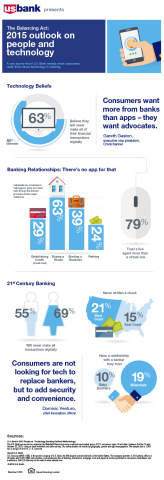MINNEAPOLIS--(BUSINESS WIRE)--Approximately 70 percent of consumers across all generations (85 percent of millennials) believe banks that are current with the latest technology are more trustworthy than banks that lag; however, nearly 4 out of 5 Americans say when it matters most, they value people more.
The findings come from The Balancing Act: U.S. Bank 2015 Outlook on People and Technology, which uncovered some surprising facts about how consumers expect to use financial services in the future.
“American consumers want more from their banks than apps -- they want advocates,” said Gareth Gaston, executive vice president, Omnichannel, U.S. Bank. “Everything we do at U.S. Bank is guided by a relationship-first philosophy. Our role in that relationship is to discover what’s possible for our customers, combine it with what they are aspiring to and guide them along the way.”
The U.S. Bank Coaches Program connects a team of industry experts to consumer issues, offering practical insight and advice on relevant topics. Coaches will share knowledge and tips in their respective areas of expertise to empower consumers to get the most from their banking relationships. From finding your passion in the community to understanding how to think about the latest technology trends, the U.S. Bank Coaches Program will provide relevant insights and new ways to think about today’s trending topics.
The team and their areas of focus include:
- Community Development: Zack Boyers, CEO, U.S. Bank Community Development Corporation;
- Community Engagement: Reba Dominski, Senior Vice President, U.S. Bank Foundation;
- Omnichannel: Gareth Gaston, Executive Vice President, Omnichannel;
- Customer Experience: Robyn Gilson, Vice President, Customer Experience;
- Wealth Management: Margaret Paddock, Senior Vice President, The Private Client Reserve;
- Innovation: Dominic Venturo, Chief Innovation Officer; and
- Cyber Security: Jason Witty, Chief Information Security Officer.
Banking Relationships: There’s No App for That
There is a rapid decline in some traditional banking methods, according to the U.S. Bank survey. Specifically, 29 percent of millennials report they have never written a check, compared to just 16 percent of Gen X and 13 percent of Baby Boomers. Despite the decline in paper checks, the survey also found people are not in favor of completely digitizing personal engagement. Almost two-thirds (63 percent) of Americans believe they will never make all of their financial transactions digitally.
Why are they reluctant to move completely into the digital realm? Nearly 80 percent of consumers fear bad customer service from banks that “go completely digital.” That could explain why 86 percent plan to bank in physical branches over the next five years. Further emphasizing the desire for personal interaction, 8 out of 10 Americans prefer working with a professional banker instead of a virtual one to resolve issues.
“Consumers are challenging the industry to meet them where they are, and that requires a mastery of the delicate balance between convenience, security, and personalized engagement,” said Dominic Venturo, chief innovation officer at U.S. Bank, and innovation coach. “That is why we don’t innovate for the sake of innovation; our products are developed with the sole intention of fulfilling a customer need. We know that consumers are not looking for technology to replace bankers, but to add convenience and security.”
Boomers’ Surprising High-Tech Appetite
When asked what technology they were most excited to try, millennials said they want to use 3-D printers in order to print debit or credit cards at home. Gen X and baby boomers are most excited to try retina scanners to sign for purchases.
Contrary to today’s headlines, in some instances, older generations are even more receptive to new technology than millennials, who are traditionally thought of as early adopters. Two out of 5 (41 percent) of respondents who are 65 years or older say they would sign for purchases with an eye scan, compared to just 22 percent of those between the ages of 18 and 24. Furthermore, those in the 65+ age group (24 percent) were almost twice as likely to try a biochip implant for making payments and all banking transactions as all other age groups.
Additional Survey Findings
The survey also offers insights into consumer behavior across geographies and gender. A sampling includes:
- Going paperless: West coast (21 percent) versus east coast (15 percent) have never written a check.
- Going completely digital: Female (69 percent) versus male (55 percent) will never make all transactions digitally.
- Trust in Bankers: Millennials (19 percent) versus boomers (10 percent) bank at branches because they have a relationship with a banker they trust.
Conducted in October 2015, the U.S. Bank survey polled more than 1,000 adults ages 18 and older in the United States to better understand consumer attitudes and behaviors toward emerging banking technologies and compares differences across gender, geography, and generation.
Minneapolis-based U.S. Bancorp (“USB”), with $416 billion in assets as of September 30, 2015, is the parent company of U.S. Bank National Association, the fifth largest commercial bank in the United States. The Company operates 3,151 banking offices in 25 states and 5,001 ATMs and provides a comprehensive line of banking, investment, mortgage, trust and payment services products to consumers, businesses and institutions. Visit U.S. Bancorp on the web at www.usbank.com.
U.S. Bank’s 2015 People vs. Technology Banking Outlook Methodology
The U.S. Bank survey was by conducted by Wakefield Research among a national represented group of U.S. consumers ages 18 and older, between Oct. 16 and Oct. 22, 2015, using an email invitation and online survey. The survey breaks out results by geography, gender and age demographics. The sample size is 1,003 and has a margin of error of +/- 3.1 percent.




